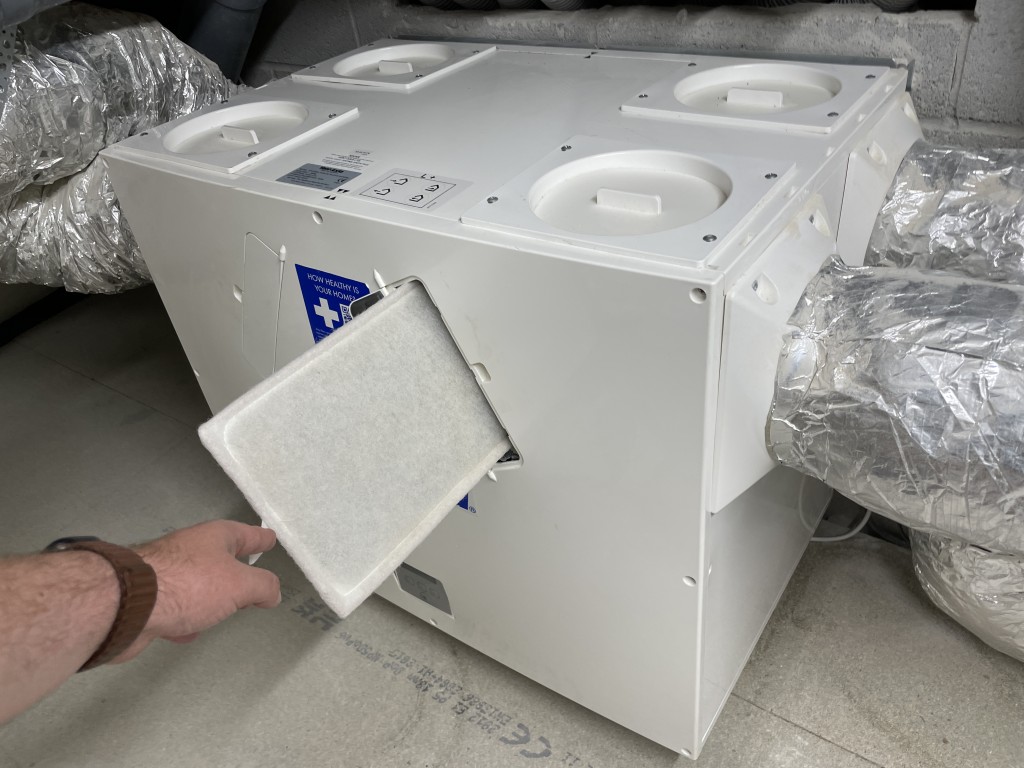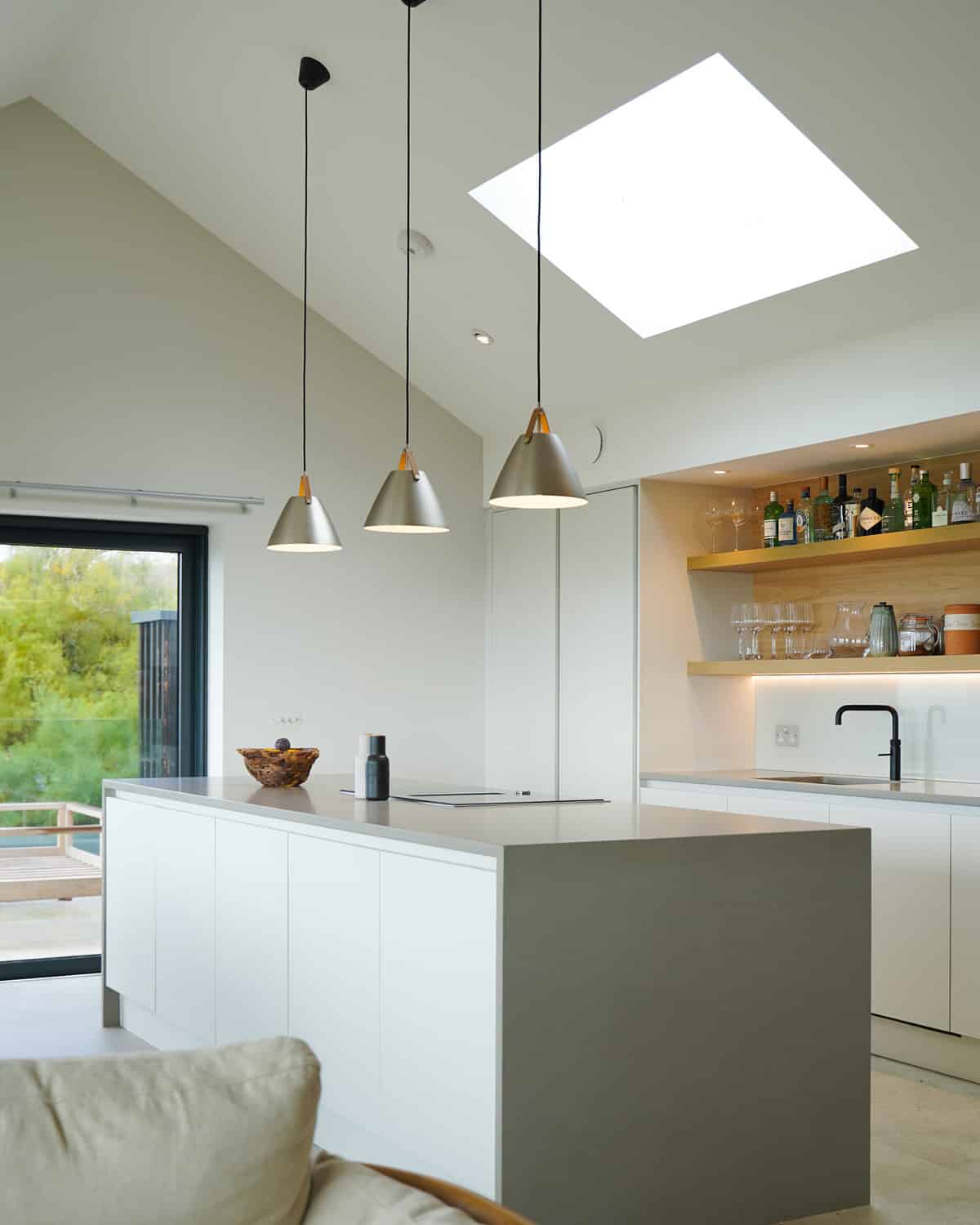MVHR or MHVR – you might have heard of it, but what is it? It’s a system to provide controlled ventilation in buildings, while minimising heat loss.
Share:
How does it work?
In any home there are rooms which generate heat, and/or moisture, like kitchens and bathrooms. There are also living areas and bedrooms, where you’d like fresh air to be circulating, at a reasonable temperature, whatever the weather is doing outside.
MVHR systems use a central unit to extract stale, humid air from your home, and pass it through a heat exchange unit, before discharging it outside. Incoming air is filtered, and passed the other way through the heat exchange unit, warming it, before circulating it to where you want it.
It’s a very simple system, quiet, and very cheap to run. It comprises a single unit, often installed in the utility room, plant area or loft, ducting throughout the house, and a pair of fans, to pull air in from outside, and draw the humid air out of the house. The units in each room are inconspicuous, but the benefits are noticeable.
Benefits to MVHR systems
Improved hygiene and air quality
- Pollen and pollutants filtered out – and windows can stay closed – great for asthmatics and people with hay fever
- No build-up of in-home pollution, from cleaning products, dust and radon – particularly a concern here in Cornwall
- Cooking smells and other bad odours removed from your home, even in open-plan spaces, ensuring a clean, fresh environment,
Humidity control
- Remove the growing conditions for mould, bedbugs, dust mites and fungus inside your home
- Eliminate condensation, improving the lifespan of the fabric of your home
Peace and quiet
- Quieter operation than air conditioning, and cheaper to run
- Windows can remain closed, so outside noises are reduced, allowing better sleep
Energy efficiency
- Reduced energy bills for heating, with minimal running costs, equivalent to 1-2 low energy bulbs
- Redistributes heat from south-facing rooms throughout the house
- No need to have windows open in cold weather
Easy to use
- You can still open the windows for temperature control, whenever you want
- Largely hands off operation, with sensors monitoring moisture levels, and automatically adjusting fan speeds
Disadvantages of MVHR
- MVHR can be costly to install, with a quality system suitable for a medium-to-large home costing £3-4,000 for the heat exchanger unit
- Easier to install in a newbuild home than to retrofit
- You can’t have open fires or wood burners with internal air supply, unless you have a dedicated external air supply
- Regular maintenance requirement, including cleaning or changing the filters every few months, or at least annually, depending on the system
- There is a cost to ensuring the levels of airtightness required to make the system efficient
What sort of homes does it suit?
The effectiveness of MVHR depends on a relatively airtight home. Current building regulations for new-build homes are for an airtightness of a maximum of 8m³/hr/m². In layman’s terms that is the flow of air into or out of a building, (measured in metres cubed), per square metre of the building, per hour. The reference pressure is 50 Pascals (Pa) inside and outside the building, but you don’t need to worry about any of this, really.
It is likely that the regulations will tighten in the near future, to less than 5m³/hr/m², but for efficient operation, an MVHR system needs the property to be less than 3m³/hr/m². Passivhaus, the best energy efficient building standard currently available, requires no more than 0.6m³/hr/m², and it’s almost always the case that Passivhaus homes have MVHR.
This is part of the reason why MVHR systems are better in new-build homes than retrofitted. An older home is much more difficult to adequately insulate to achieve this level of airtightness. It’s also the case that fitting ducting into an existing property to carry an MVHR system can be complex, and quite costly. It’s not impossible, but it’s definitely more difficult than designing it in at the start of a new-build.
For any energy-conscious new home, MVHR is an excellent way to optimise your heating system, whatever that is. It pairs well with ground or air source heat pumps, and can be installed alongside underfloor heating, and your home’s other services.

Richards, MVHR and your home
When our clients ask for MVHR systems, we will work with our electrical contractors to spec the best system for their home, and budget. There are calculations around the size of the property, to ensure that the system is optimised for the home. It is important that the system runs at no more than 70% efficiency, to avoid overloading the fans, which may seem like a waste, but running the fans too high will cause additional noise.
We almost always use Vent-Axia units, which come highly recommended for their excellent controllability and reliability, but we are not constrained to that brand if another is better for the situation. The system is installed by our electrical contractors, during the course of the build, allowing for the ducting to be fitted along with the other services, and appropriate airtightness to be achieved.
Other factors and stats to know about
Ventilation heat loss can account for around 30% of the heat lost from a property, which MVHR can almost completely eradicate.
All domestic MVHR units in the UK use Counterflow heat exchangers, which ensure that the internal air flowing out and the external air flowing in do not mix. They are also more energy efficient than the alternative, rotary wheel heat exchangers, which are recommended for office spaces, if you’re familiar with that setup.
In many systems, approximately 80% of the heat from the extracted air is transferred to the introduced air.
You should look for a system that is at least A rated for energy efficiency, and you can look up performance ratings, to compare different systems, if you wish.
Many systems have a ‘boost’ function, that you can use if you’re taking a shower, or are generating a lot of steam in the kitchen. Check for this if you think it’s something you might need.
Some systems have a summer bypass mode, which turns off the heating function for incoming air, if the air outside is already warmer than you need it.

If this sounds interesting, and you want to discuss it in more depth, drop us a line, and we can help you explore the options for your project.




